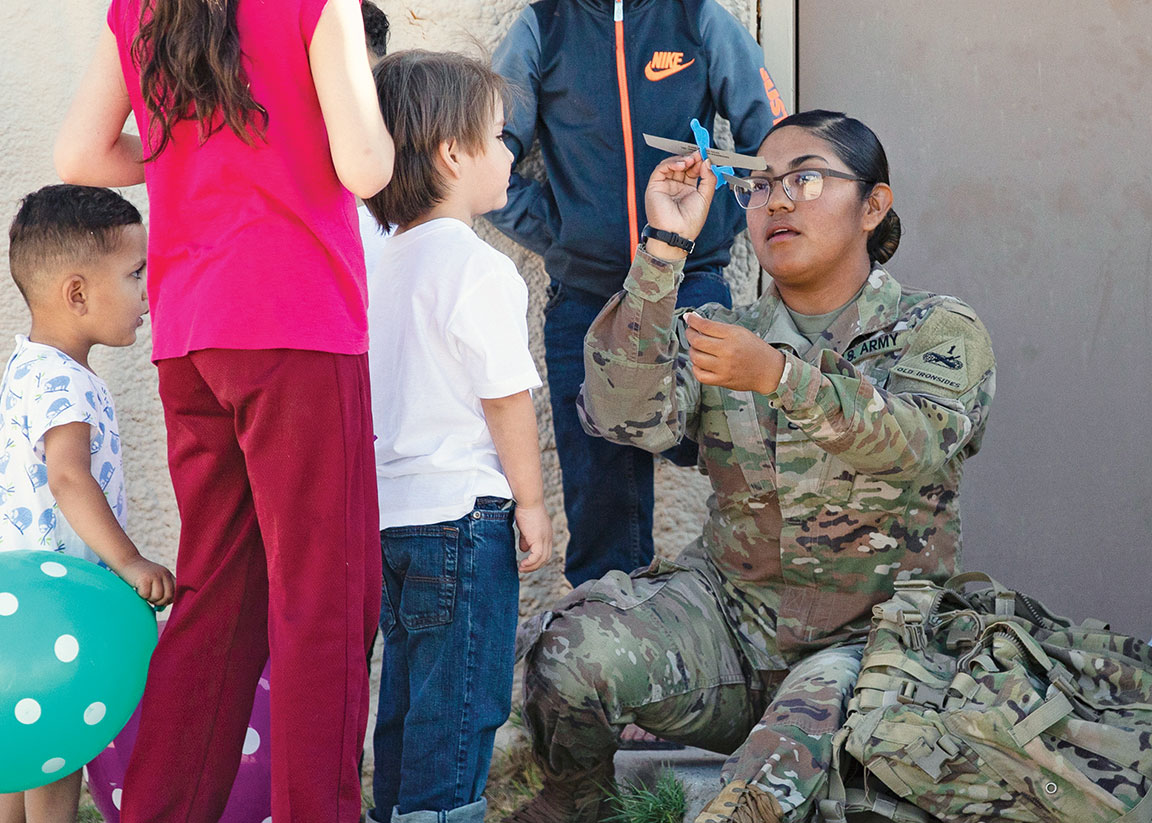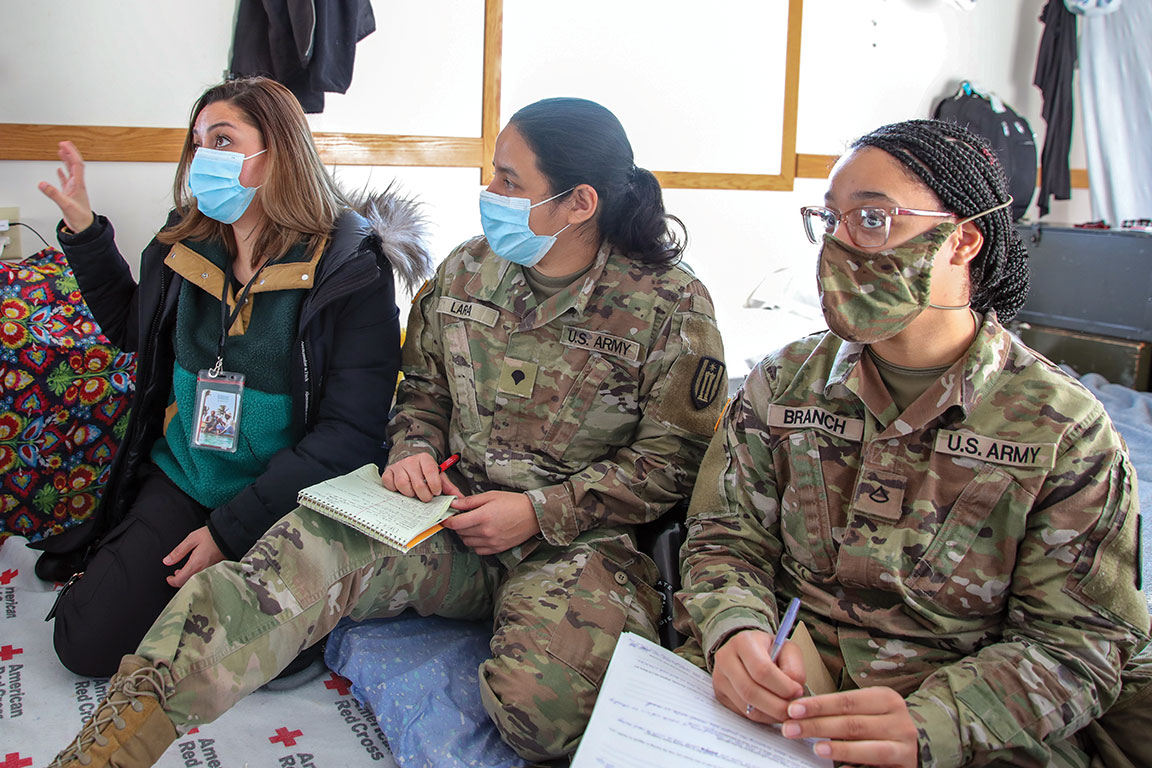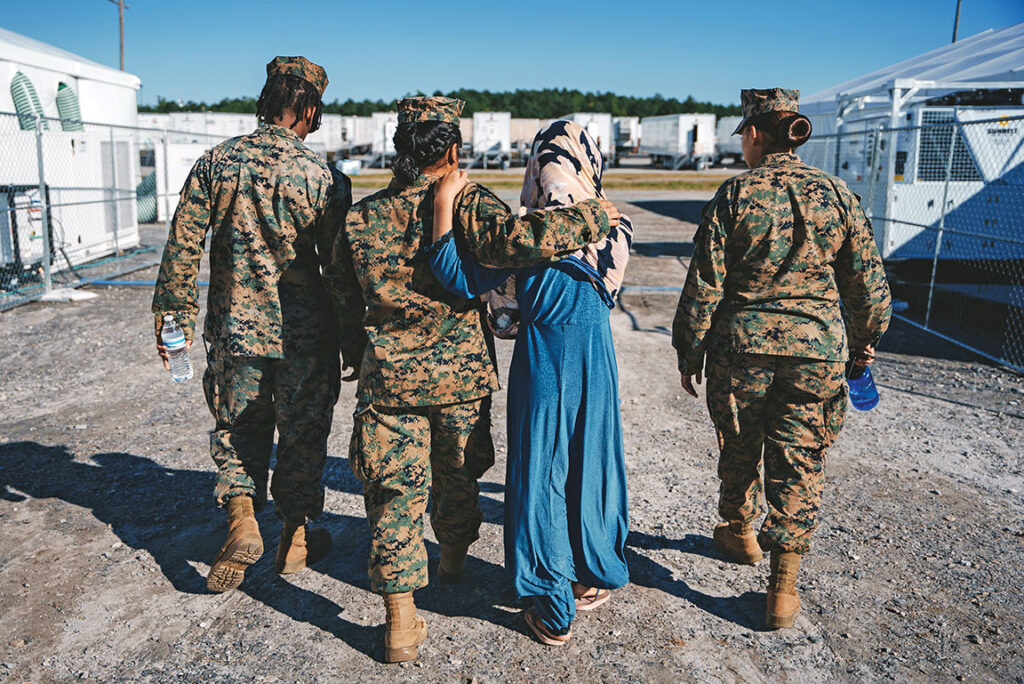U.S. Marines assigned to the Female Engagement Team with 3rd Battalion, 6th Marine Regiment, escort an evacuated Afghan woman at Fort Pickett, Virgina, on September 24, 2021. Comprised of female volunteers, the Female Engagement Team helped build trust with the displaced Afghan guests to see to their needs. CPL. COREY A. MATHEWS/U.S. MARINE CORPS
DR. HOLLY PEIRCE/U.S. STATE DEPARTMENT AND TIFFANI PHILLIPS/U.S. NORTHERN COMMAND
U.S. President Joe Biden’s 2022 National Security Strategy states, “the challenges of our age, from strategic competition to climate change, require us to make investments that sharpen our competitive edge and bolster our resilience.” The Women, Peace, and Security (WPS) program is a tool to do exactly that.
From a U.S. perspective, WPS exemplifies America’s core strategic advantages and positions the nation to outmaneuver its geopolitical competitors. In the words of Gen. Glen D. VanHerck, former commander of the North American Aerospace Defense Command (NORAD) and U.S. Northern Command (USNORTHCOM), “In today’s extremely complex strategic environment, we are vying for allies and partners — our asymmetric advantage. Women, Peace, and Security is a part of strategic competition. Our global competitors seek to exploit, to undermine our shared values in democracy, human rights, self-reliance and self-determination. Yet, like-minded nations who embrace Women, Peace, and Security are able to create a golden thread between allies and partners which shores up our beliefs in democracy, sovereignty, and freedom which our competitors seek to erode.” Gen. Laura J. Richardson, commander of U.S. Southern Command, stated in her congressional testimony that “women play an important role in increasing readiness and sustaining regional stability, security, and prosperity, and so we must redouble our efforts to integrate and institutionalize Women, Peace, and Security initiatives internally and among all our partners.”
USNORTHCOM’s approach to Women, Peace, and Security is based on the related United Nations Security Council resolutions, the U.S. National Strategy on WPS, the WPS Act of 2017 and the 2020 Department of Defense WPS Strategic Framework and Implementation Plan (SFIP). The SFIP compels the DOD to exemplify a diverse organization that allows for women’s meaningful participation across the development, management and employment of the joint force. It ensures that women in partner nations meaningfully participate and serve at all ranks and in all occupations in defense and security sectors, that women and girls are safe and secure, and that their human rights are protected, especially during conflict and crisis.

In 2020, Gen. VanHerck released WPS implementation guidance and identified WPS as a command priority, instructing USNORTHCOM staff and its components to “integrate WPS principles into their strategies, plans and operations to better defend the homeland, strengthen partnerships, and provide flexible responses to civil authorities.” That same year, the NORAD deputy commander appointed the first Canadian Element NORAD Gender Advisor. Together, the commands have more than 40 trained gender focal points and gender advisors embedded across the staff, components, regions, subordinates and in U.S. embassies in our areas of responsibility to ensure a gender perspective is applied across functions and our missions of homeland defense, defense support of civil authorities and theater security cooperation. The NORAD and USNORTHCOM WPS team also is part of the larger DOD network of more than 500 joint staff trained personnel.
Also, USNORTHCOM is fortunate to have strong, reliable WPS partnerships with Canada, Mexico and the Bahamas, as well as strong regional partnerships with the Ted Stevens Center for Arctic Security, the Western Hemisphere Institute of Security Cooperation, the William J. Perry Center for Hemispheric Defense Studies and the Inter-American Defense Board, which also support WPS implementation. North America is uniquely positioned to lead the way in WPS implementation.
WPS is an area where we, together with our partners, are significantly outpacing our competitors. The contrast could not be more profound. While our competitors embrace an over-masculinization of their militaries and face accusations of deliberate acts of gender-based violence, in North America we are legislating WPS, developing and implementing national action plans and leading with feminist foreign policies and gender-optimization policies. Of note, none of our competitors has created WPS national action plans or benefit from a focus on human security. This gives us an advantage. We recruit, train and employ differing teams. These teams are better positioned to address complex challenges, reflect and serve the populations they interact with and build trust and resilience within our teams and nations.
Evidence conclusively supports that inclusive, diverse organizations and societies that leverage and respond to diverse population strengths, capabilities and needs are more effective and resilient during and after times of crises. Additionally, when populations experience conflict and crisis, it is critical to understand the different needs of the population to tailor our response and support.

USNORTHCOM did this recently in support of the resettlement of vulnerable Afghans during operation Allies Welcome. USNORTHCOM conducted the first deployment of gender advisory support during a DOD and defense support of civil authorities operation to provide tailored assistance to Afghan guests and facilitate their successful resettlement. The lessons learned from this unique deployment continue to shape the future of the DOD gender advisory workforce and expand the operational contexts considered for the implementation of WPS across the department and interagency.
In keeping with the National Security Strategy, investing in and leveraging the talents of all our people strengthens our democracy and partnerships with like-minded nations. Modeling diversity and inclusion and prioritizing protection of vulnerable populations bolsters our national resilience. This enhances our credibility on the world stage and ensures our competitive advantages.
According to the United States 2023 National Strategy on Women, Peace, and Security, “The implementation of the WPS agenda is both a moral and a strategic imperative for U.S. foreign policy and national security. Research shows that the status of women and the stability of nations are inextricably linked: higher levels of equality make countries more prosperous, secure, and democratic; conversely, lower levels of gender equality result in greater instability, corruption, and conflict.”

